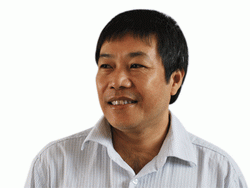
| Tuesday, September 8, 2009 |
Artist and illustrator Harn Lay is living proof that no amount of repression can suppress free thought. When the present military regime seized power in Burma in 1988 he went into exile in Thailand, where he continues to use his skills to combat the brutality of the junta. His work appears regularly in The Irrawaddy, which has just published a second collection of his political cartoons.
Born in Shan State into an artistic family, Harn Lay entered Rangoon’s School of Art in 1982. Among his teachers were renowned artists such as Thu-Kha, Ba Kyi and Tin Aye.
 |
After fleeing Burma in 1988, Harn Lay settled in Chiang Mai and became The Irrawaddy’s house cartoonist six years ago. In an interview with The Irrawaddy’s Aye Chan Myate, he talked about his life, work and political views:
Question: How do you feel about the latest publication of your collected cartoons?
Answer: I feel both satisfied and proud. I have been drawing political cartoons for The Irrawaddy for quite a long time—at least two a week, meaning eight a month. I selected what I thought were the best and published my first collection in 2006. The recent book is second. I selected 50 from 200. Actually, I am not that satisfied with it. I’m planning a third book, which will be better.
Q. You’re especially attracted to political cartoons?
A. I have been drawing many cartoons because I am not happy with the situation of my country. I don’t enjoy targeting one subject since the beginning. It doesn’t make me happy. If my country were a democracy, the target of my satirical cartoons would change virtually every four years.
I’m making jokes only about the SPDC junta. I even can draw in advance if they are going to do something. I can predict the result in advance. Not only me, though. The entire population knows the results of their plans in advance.
Q. How do you see politics from the cartoonist’s viewpoint?
A. Cartoons and politics are like husband and wife. It’s similar to journalists. The world can’t exist without journalists, and it’s the same with cartoonists. Politicians may hate cartoonists, but it can't happen without cartoonists. If there were no politicians, cartoonists couldn't stand alone. Cartoons reflect peoples' opinions, and they don’t [necessarily] match those of the government. Cartoons are not just amusing. They are a medium and in some cases they can be used to present ideas as illustrations, in place of photos, also for educational purposes. Presenting cartoons instead of photos in some particular cases is courteous and useful. Cartoons can also be sometime a supportive thing, they can allow people to remember an idea into their old age. For example, I still remember Ba Kyi's cartoon about the Kyan-Sit-Tha and Na-Yan Man Kan story, which I read in my childhood. Even after 30 years, I can still picture this cartoon.
Q. How do you feel about your participation as a cartoonist in a media which is promoting democracy?
A. I am proud of that. But I don't feel self-satisfaction. The cartoonists working inside Burma have qualified themselves while struggling under oppression. As I said, I am not satisfied, I think I should do more. However, I can't think beyond my limits. I feel frustration to some extent. All I can do is just sooth the irritation of the people. I want to give the people more.
A cartoonist is not capable of changing a government. But he can be a good recorder of history.
Q. Who are your idols among cartoonists, illustrators and painters?
A. I likeBa Kyi the best for his illustrations. Cartoonist Win Maung is so moving and I respect cartoonist Aw Pi Kyal.
Q. You draw cartoons as well as paint. What differences are there?
A. I am a fanatic of both cartoons and painting. I paint with my emotion. Other people may like the painting immediately, or they may not like it, depending on their emotion. Cartoons tell other people’s feelings by sharing their sentiment. For instance, I empathize with people and feel how bad their lives are. Cartoons are rather like giving while painting is something like taking.
Q. How do you define "cartoon"?
A. Cartoons are similar to journalism. Sometimes, people will applaud your work, but sometimes they may fault you. I accept both of these responses. As I say in my cartoon collection book, a cartoon is like a child and it is innocent. It will expose as fully as it sees. It will have no bias on any side.
Q. You are really good at drawing Snr-Gen Than Shwe’s caricature.
A. Because I have been drawing him for more than 20 years.
Q. What would you tell him if you met him on the street?
A. I would like to say to him: you just keep your strong and powerful power on your belt. If you put this power either in your head or in your heart for the benefit of the state and the people, it would be superb.